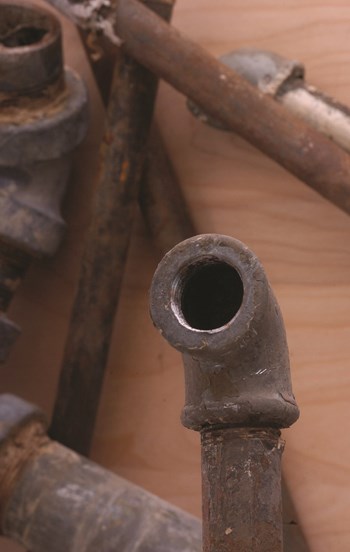
While Flint, Michigan may have been the highest profile case of water being contaminated with lead in recent years, lead is an issue that water systems across the country have to navigate and monitor closely.
Earlier this year, elevated levels of lead were found in the drinking fountains at two Boston public schools; the fountains were shut down, and two school department employees were placed on administrative leave. In June, Massachusetts regulators announced that 20 school districts in the state had levels of lead that were above regulatory limits in their water.
And the problem is not limited to schools. In August, hundreds of homeowners in Newton, Massachusetts, received notices that the service lines to their homes might contain lead.
Similarly, according to Florida Today, almost 50,000 people in that state were potentially exposed to unsafe lead levels in drinking water between January 2012 and June 2015. In the past several months, there has been a barrage of similar news stories about lead-contaminated water.
The crisis in Flint, Michigan originally began in April 2014 when officials changed the water source from Lake Huron and treated rivers in the Detroit basin to the Flint River, from which officials had failed to add anti-corrosive measures. Thereafter the drinking water had a series of problems that culminated in lead contamination, creating a serious public health danger. The corrosive Flint River water caused lead from aging pipes to leach into the water supply, causing extremely elevated levels of the heavy metal.
Piping Up
Despite all of this, lead in the water system isn’t something that most people tend to think or even worry about during their day-to-day lives. Part of the reason for that is because local municipalities and water companies go to great lengths to make sure that the water is not only safe, but will remain so as it travels through the pipes and into our homes—no matter what those pipes are made of.
“If they look at the water chemistry, they can add something that helps maintain the scale that’s built up on the inside of lead pipes; typically it is going to be orthophosphate, to keep the lead from dissolving into the water,” says Greg Kail, the director of communications at the American Water Works Association, a non-profit focused on managing and treating water.
Part of the reason water is treated is for corrosion control, to ensure that even if water passes through lead pipes it won’t leach lead from the pipes and contaminate the water. The substance often used, orthophosphate, creates a coating on the inside of pipes to prevent corrosion. Part of what went wrong in Flint, according to a study by the Natural Resources Defense Council (NRDC), is a lack of corrosion control.
“There can be times during a community’s growth or based upon environmental factors that they need to change their water source or add to it. In all those cases, the water professionals at the treatment plant need to look at what impacts that those changes are going to have on their water quality, whether it be how it impacts corrosion or if it requires a different treatment, and there are often unintended consequences that the utility has to prepare for, model and eliminate before putting that new water source online,” says Kail.
So when Flint changed water sources, according to the NRDC study, corrosive water leached lead from the pipes and damaged the protective film that had built up.
Where is the Lead?
“The problems with lead occur in really two main sources, one is home plumbing, lead solders, some brass fixtures, wherever lead might have been used inside the home. And then the other potential source is if the home or business has a lead service line leading to it, and we did a study to look at that. Based on our best estimate, there are about 6.1 million lead service lines in the United States that remain out there. So there’s been some progress made over the decades, but there’s still a lot to go. The first and best protection is to remove those potential sources of exposure. Now, some people don’t know if they have a lead service line or if they have lead in the home. They can do something; they can certainly contact the water utility,” says Kail.
Those service lines Kail mentions are the lines that connect buildings, be they private homes, businesses or large condominium or co-op associations, to the water mains running under the streets. If there’s going to be a problem, like there was in Flint, that’s likely where it’s going to be. “Lead pipes were outlawed in 1986 but it’s very difficult for the water system to know what has been done, what work’s been done on particular properties, so in many cases, their knowledge of the situation is going to be incomplete, at best,” says Kail.
“Any building built prior to 1940s could have a lead main water service that runs from the street into the building,” says Fred Webster Jr., owner of Milltown Plumbing & Heating in Chelmsford, Massachusetts. “Folks with older properties, there’s definitely the potential that some of the main lines could be made of lead piping and they would want to have them replaced.
“Today, anything that’s newly installed has to be 100 percent lead-free, so if you have new construction, you don’t have to worry about that.” Older, urban buildings —those built before the ‘40s — “there’s a greater potential; up until 1989, it will still be a concern; after 1989, up until even just a few years ago, it will still be there but it will be less.” Webster says. “Now, it’s zero tolerance.”
That’s not to say there aren’t other places lead can find its way into the water system—lead solder, brass fixtures, maybe an older building still has some lead pipes—but due to changes in the law since the late ‘80s the service lines are most likely to be the culprit, as they aren’t often worked on.
“You don’t typically see lead piping (inside the building), however, there was lead in a lot of solder until 1989, just at the connections. The concentration is not nearly as high as in a piece of piping that was made of lead 100%,” Webster explains. But there may be lead in older connections and fittings, though newer ones are lead-free. “The real concern is when you first draw a glass of water in the morning off a line that’s been sitting sedentary in the piping system overnight,” Webster says. “One way to protect yourself is to let the water run until it gets cold,” Webster says. “It will have a lower concentration of lead in it. So if people are concerned, that would help.
“The worst thing you can do,” he cautions, “is if you make tea with water that has been sedentary inside a system that has a high lead content and then you boil the water out of it … then you are drinking a high concentration of lead.”
So how do you know what your building has for piping? “The way to determine that is if the piping is grey in color coming into the home and you can scratch it with a key easily and it peels back, it could be lead and you should have the water tested or have the piping checked by a plumber, someone that can certify that it is in fact lead,” he says. Concerned homeowners or associations can take a water sample to a Mass DEP registered lab for testing, he adds.
Who should be checking on that? Owners of townhouse-style condos are generally responsible for the piping in their homes, while the association would be in charge in condo buildings with shared spaces and utilities. Of course, the board of your building doesn’t need to appoint a specific officer to go check the pipes around the building or the service line in the basement. While the board should take responsibility and make sure there are no lead pipes, anyone can check to be sure.
What Can Happen
“There is no safe level of lead exposure. EPA has established a health-based maximum contaminant level goal for lead of zero. Lead exposure is of particular concern for children under 6, because their growing bodies absorb a larger portion of the lead to which they're exposed, and because their developing brains and nervous systems are more sensitive to lead. Exposure of pregnant women to lead can adversely affect both the mother and the infant, and lead is also harmful to adults,” says Monica Lee, the Environmental Protection Agency’s deputy press secretary.
In adults lead poisoning has been linked, in addition to death, to cardiovascular effects, increased blood pressure and incidence of hypertension, decreased kidney function and reproductive problems in both men and women, according to the EPA. In pregnant women, lead poisoning can result in serious effects including reduced growth of the fetus and premature birth. Children are susceptible to even low levels of lead and have suffered from anemia, hearing problems, slowed growth, hyperactivity and learning problems.
As a result of this, “Congress, in the Safe Drinking Water Act, directed that EPA establish treatment techniques to prevent adverse health effects to the extent feasible. EPA developed a lead action level for drinking water of 15 parts per billion, based on an evaluation of the feasible level of lead in drinking water in homes with leaded plumbing materials that receive non-corrosive water,” says Lee.
In addition, she notes, “If 10 percent of the tap samples collected in accordance with the Lead and Copper Rule exceed the action level of 15 ppb, then water systems must take additional steps such as public education and lead service line replacement to reduce drinking water lead exposure. The rule is intended to minimize risks to public health but does not eliminate them.”
Replacing Pipes and Testing Water
If you do an inspection and happen to find a lead service line or other lead pipes in the building, don’t panic. There are tests that can be done to determine if they are leaching lead and contaminating the building’s water supply.
“I'd encourage them to be in contact with their utility to have that water tested at the tap. Again water coming from the treatment plant is not going to contain lead in significant amounts, so that's what makes it different. The utility can sample in a community and that sampling is intended to check to see if their corrosion control is effective, but it can't guarantee in every case that a customer doesn't have a problem,” says Kail.
According to the EPA you can also get in contact with a lab, found in the yellow pages under ‘laboratory,’ and have them test as well.
“Just because there are lead pipes doesn’t mean that there’s lead particles getting in your water that could poison you. If the water’s tested, I would imagine that if it tested positive then they wouldn’t be living in that building. They would be moved out and they would be going through their insurance and be put up in a hotel until it’s properly fixed. That’s just what I think would happen,” says Leibowitz.
If you do find your service line, or any other pipes, are lead-based then you should go about getting them replaced.
“I say the best way to bring in the most confidence is to remove those sources of lead exposure, which may not always be a cheap fix. In most cases, the utility would own part of a service line, the customer would own part, so there’d need to be some discussion of what could be done to remove the customer’s side. Some utilities have payment plans, there are some communities that have affordability programs,” says Kail.
The difficulty, and cost, of replacing a service line from the street can vary greatly, Webster says, depending on issues ranging from the distance to the landscaping or hardscaping that will be disturbed by the work. “It could range from $5,000 to $30,000 or $40,000,” he says.
So while the utility will do what it can to ensure that the water coming in through your pipes is safe, there’s more that everyone can do to decrease the risk of exposure. “We do that as a society for lead paint and dust, but we haven’t been as active with lead service lines. Part of that is certainly because it’s not as common a source of exposure. But when you’re looking at the overall exposure that a person can receive, it’s certainly part of, I think everyone agrees that rather than only communicating about it when there is some exceedance of the lead and copper rule, it should become a more regular part of our utility and community communications,” says Kail.
John Zurz is a staff writer at New England Condominium. Associate Editor Pat Gale contributed to this report.






Leave a Comment